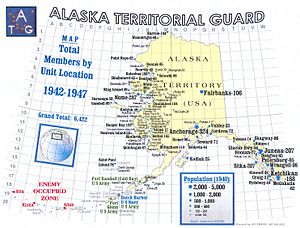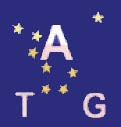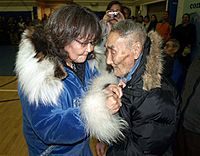Alaska Territorial Guard facts for kids
Quick facts for kids Alaska Territorial Guard |
|
|---|---|

Map showing the locations of Alaska Territorial Guard units (with membership counts), major military bases, and evacuated Aleutian villages.
|
|
| Active | June 1942 – March 31, 1947 |
| Country | |
| Branch | |
| Type | Military reserve force |
| Role | Defense of Alaska |
| Size | 6,389 personnel |
| Garrison/HQ | Juneau, Alaska Territory, United States |
| Nickname(s) | Eskimo Scouts, Tundra Army |
| Engagements | World War II |
| Commanders | |
| Notable commanders |
Marvin R. Marston |
The Alaska Territorial Guard (ATG) was a special group of volunteers who helped defend Alaska during World War II. They were also known as the Eskimo Scouts or the Tundra Army. This group was formed in 1942 after Japan attacked Hawaii and took over parts of Alaska. The ATG operated until 1947.
About 6,389 volunteers joined the ATG from 107 communities across Alaska. These brave people served without pay. They came from many different backgrounds, including Aleut, Athabascan, White, Inupiaq, Haida, Tlingit, Tsimshian, and Yupik people.
Many ATG members became excellent sharpshooters. Some women also joined, and at least one woman was a better shot than the men! Members ranged in age from 12 to 80 years old. Many were too young or too old for the regular army draft.
Some people estimate that around 20,000 Alaskans helped the ATG, even if they weren't officially members. They helped with things like scouting and support.
The ATG played a very important role during World War II:
- They protected the only source of the important metal platinum in the Western Hemisphere from Japanese attacks.
- They kept safe the land around the Lend-Lease air route. This route was used to send planes from the United States to the Soviet Union.
- They set up and looked after emergency supply spots, especially along roads and coasts.
Beyond their military duties, ATG members also helped bring people of different races together. They worked for racial equality in their communities and within the US Armed Forces. After the war, many former ATG members helped Alaska become a US state in 1959.
In 2000, a law was passed that officially recognized all ATG members as US veterans. This was a big step, but finding all the surviving members has been hard. Many records are missing, and some communities relied on oral history.
Contents
Why the ATG Was Needed
Before World War II, many US military leaders thought Alaska was too far away to protect. They also thought it wasn't very important for defense.
For example, in 1937, a US Army Chief of Staff said it was "difficult to imagine" how air operations from Alaska would help national defense. This idea changed a lot after the war, especially during the Cold War. By 1971, a general called Alaska's troops the "real first line of defense" against Communist Russia.
In August 1941, all Alaska National Guard units were moved out of Alaska. This left Alaska with no military reserves or local defense groups. This meant that nearly 34,000 miles (54,718 km) of US coastline were left unprotected.
Meanwhile, Japan showed a clear interest in Alaska. In early 1942, a Japanese Navy team was seen secretly mapping the Alaska coastline. Japanese soldiers even walked onto American soil and asked locals about the economy.
There were many sightings of enemy planes and submarines. This caused a lot of fear. In June 1942, Japanese forces attacked Dutch Harbor and took over the Aleutian Islands of Attu, Kiska, and Adak. This made it clear that Alaska needed its own defense.
How the ATG Started
After the attack on Dutch Harbor, Major Marvin R. Marston had an idea. He suggested that local citizens could defend the entire Alaska coast. He thought of this plan while visiting Saint Lawrence Island.
Alaska's governor, Ernest Gruening, liked Marston's idea. Governor Gruening had been trying to organize a new guard for Alaska since the National Guard left.
Because of the Dutch Harbor attack, Major Marston and Captain Carl Schreibner were quickly assigned to help Governor Gruening. Soon after, Gruening and Marston flew to start setting up ATG units. One of the most important places they visited was Platinum. This tiny mining town was the only source of the important metal platinum in the entire Western Hemisphere.
The effort to sign up volunteers continued into early 1943. The organizers traveled in all kinds of weather. They used airplanes, boats, snowmobiles, walked, and even used dogsleds. Dogsleds were the most reliable way to travel in the region.
Major Marston once had to travel 680 miles (1,094 km) by dogsled around the Seward Peninsula. This was during the coldest winter in 25 years. He survived by using native survival methods, taught by his guide, Sammy Mogg.
Thanks to their hard work, the ATG became the first line of defense for the land around the Lend-Lease route. This route was vital for sending military planes from America to the Soviet Union. It helped Russia survive during a tough time in the war.
How the ATG Was Organized
The Alaska Territorial Guard was created in June 1942. It was led by Governor Ernest Gruening, who was its Commander-In-Chief. All members promised to follow the Governor's orders. The main office was in Juneau.
What the ATG Did
The main job of the ATG was to defend Alaska's entire coast. Attacking the enemy was the job of larger military forces based in places like Dutch Harbor and Anchorage.
A key part of the ATG's mission was to protect the land around the Lend-Lease air route to Russia. Warplanes were flown from Great Falls, Montana to Whitehorse, Canada, then to Ladd Field, Alaska, and on to Nome. From Nome, Soviet pilots took the planes to Russia.
The ATG operated from June 1942 until it was officially ended on March 31, 1947.
Where the ATG Served
Alaska was split into Eastern and Western Areas. The Western Area had its main office in Nome. Other staff were in places like Koyuk and Gambell on Saint Lawrence Island.
The Eastern Area was based in Juneau. Staff were also in places like Ketchikan and Sitka.
Who Joined the ATG
The ATG was made up of people from 107 communities and many different ethnic groups. These included Aleut, Athabascan, White, Inupiaq, Haida, Tlingit, Tsimshian, and Yup'ik people.
The ATG used the same rank system as the US Army. However, no member went higher than Lieutenant Colonel. Most members were of Private rank.
Only 21 staff officers were paid and worked full-time. Everyone else was a part-time volunteer and did not get paid.
At least 27 women were members of the ATG. Most women worked as nurses at the hospital in Kotzebue. But at least one woman, Laura Beltz Wright, served in the main mission alongside the men. She was known as the best sharpshooter in her company, hitting 98% of her targets!
ATG members ranged in age from 12 to 80 years old. Even though the official minimum age was 16, younger and older people joined, especially in remote areas.
In total, there were 6,389 official members of the Alaska Territorial Guard. Major Marston estimated that about 20,000 Alaskans helped the ATG in some way, even if they weren't official members. They helped with things like food service and repairs.
What the ATG Did
All ATG members, except the 21 paid staff, were volunteers. They had to do their ATG duties while also dealing with the tough challenges of living in Alaska's cold and harsh environments.
The ATG trained for and carried out many important tasks:
- They gave out weapons and ammunition.
- They taught members how to drill and practice shooting.
- They moved equipment and supplies.
- They built ATG buildings and facilities.
- They helped build airstrips for other military groups.
- They patrolled coasts and inland areas.
- They created hundreds of miles of wilderness trails.
- They set up and fixed emergency shelter cabins.
- They distributed emergency food and ammunition for the US Navy.
- They fought fires.
- They performed land and sea rescues.
- They fought against the enemy.
The ATG was praised for several actions:
- Shooting down Japanese air balloons that carried bombs and listening devices.
- Rescuing a downed airman.
Some ATG members also provided medical care at the field hospital in Kotzebue.
ATG Artists
During the 1930s, as part of FDR's New Deal programs, many artists were hired by the Works Progress Administration (WPA). When World War II started, some WPA artists worked for the War Department. A few of these artists came to Alaska to record the Aleutian Campaign and other military actions, including the new Alaska Territorial Guard. Some of their art was used on wartime posters across the country.
Some of these artists included:
- Magnus Colcord "Rusty" Heurlin - An ATG lieutenant, his paintings were used for posters like "Back the Attack" and "From Metlakatla to Barrow - The Territorial Guard."
- Henry Varnum Poor - His painting "Major Muktuk Marston Signs Up Soldiers" is now in the Pentagon's Hall of Fame.
Other well-known artists from Alaska also gained more attention through their connection with ATG members and artists:
- Florence Nupok Malewotkuk - A Siberian Yupik artist from Saint Lawrence Island. Her work was promoted by Otto Geist, who later became an ATG major.
- George Aden Ahgupuk - An artist from Shishmaref. He became friends with Major Marston, who wrote about his art.
How the ATG Made a Difference

Many former ATG members played a big part in Alaska becoming a US state. In 1958, three of the eleven members of the Alaska Statehood Committee were former ATG members. Seven delegates to the Alaska Constitutional Convention had also served in the ATG.
The ATG successfully helped bring racial integration to the US Army. They showed how valuable Native Americans were as soldiers, much like the Navajo, Comanche, and Choctaw Code talkers did elsewhere during World War II.
ATG members also worked to promote racial equality in their communities. They insisted that Native people and White people be treated equally in public places like movie theaters and restaurants.
Recent Efforts to Recognize ATG Veterans
In 2000, Ted Stevens, a US Senator from Alaska, sponsored a bill. This bill ordered the Secretary of Defense to give Honorable Discharges to all Americans who served in the Alaska Territorial Guard. Senator Stevens was a World War II veteran himself.
President Bill Clinton signed the bill into law in August 2000.
It was hard to find and inform all the surviving ATG veterans about this new law. Many were very old and lived in remote areas. So, in 2003, a temporary position was created to help. Retired Colonel Robert A "Bob" Goodman took on this job. After the position ended, Bob continued the work on his own. In 2006, he started the Alaska Territorial Guard Organization (ATGO), a non-profit group.
Bob Goodman and the ATGO have helped about 150 ATG members get their honorable discharges. They believe there are still hundreds more to find. They have spoken to senators, governors, and other groups to support the ATG members and their families.
Important Dates for the ATG
- 1931 - The Imperial Japanese Army invades northeast China, showing its goal to control Asia-Pacific.
- 1935 - Billy Mitchell says Alaska is important for defense, but US military leaders don't listen.
- 1937 - The US Army officially says no to building an air base in Alaska.
- 1939 - Ernest Gruening becomes Alaska's governor. He organizes four National Guard units in Alaska.
- 1940, May - US Congress approves an air base in Alaska.
- 1941, August - The US Army moves Alaska National Guard soldiers out of Alaska. This leaves Alaska with no military reserves.
- 1941, December 7 - Japan attacks Pearl Harbor, Hawaii. Families of soldiers are told to leave Alaska.
- 1942, Feb-March - A Japanese Navy team is filmed secretly mapping the Alaska coastline. Japanese soldiers question locals.
- 1942, March - Major Marston realizes a 'tundra army' can defend Alaska.
- 1942, June - Japanese forces attack Dutch Harbor and take over Attu, Kiska, and Adak.
- 1942, June - Major Marvin Marston and Captain Carl Schreibner are assigned to help Governor Gruening. They start forming the first ATG units.
- 1943, January - Major Marston finishes his long dogsled trip around the Seward Peninsula.
- 1945, August - VJ Day, Japan surrenders.
- 1947 - The Alaska Territorial Guard is officially ended.
- 1966 - The State of Alaska gives a medal to all ATG members.
- 2000 - US Senator Ted Stevens' bill grants ATG members full veteran status.
- 2003 - Robert A. "Bob" Goodman starts finding former ATG members to help them apply for veteran recognition.
- 2006 - Bob Goodman starts the Alaska Territorial Guard Organization to continue his work.
Noted ATG members
- Atwood, Robert - Editor of the Anchorage Times, ATG lieutenant, helped with Alaska Statehood.
- Egan, William A. - ATG corporal, helped write Alaska's Constitution, became Alaska's first state governor.
- Geist, Otto William - ATG major, helped promote Alaskan artist Florence Nupok Malewoktuk.
- Gruening, Ernest - Alaska's governor, founded the ATG, later became a US Senator.
- Heurlin, Magnus Colcord "Rusty" - WPA artist, ATG lieutenant, famous Alaskan artist.
- Ipalook, Fred - Inupiaq native, ATG lieutenant, a teacher for 39 years.
- Ipalook, Percy - Inupiaq native, ATG chaplain, helped with Alaska Statehood.
- Johnson, Maurice Theodore - ATG member, helped write Alaska's Constitution.
- Marston, Marvin R "Muktuk" - Major in the US Army, organized the ATG in Western Alaska, wrote a book about the ATG.
- Mogg, Samuel Snell "Sammy" - ATG lieutenant, guided Major Marston on his long dogsled trip.
- Peratrovich, Frank J. - Tlingit native, ATG captain, mayor, helped with Alaska Statehood and writing the Constitution.
- Wright, Laura Beltz - ATG member, known as the best sharpshooter in her company.
See Also
- Former United States special operations units
- Shadow Wolves



